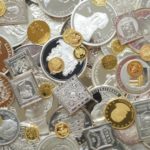Gold Demand Supported as Central Banks Sour on Dollar-Denominated Debt
(April 2, 2019 - By Javier E. David, Yahoo Finance)
Central banks, with their policy arsenals limited by debt-laden balance sheets, are slowly but surely warming up to gold as a reserve asset. It’s a development that’s likely to bolster yellow metal prices already on a tear.
Spot gold (GC=F) is modestly higher on the year, but has added more than 12% since last August, when it languished below $1200 per ounce. Last month, Goldman Sachs forecast gold prices would rally by around 10% in the next year, to $1425, compared to its current levels near $1300.
Markets are largely distracted by the growing prospect of a slowing economy, rising global debt balances and a U.S. yield curve that may be signaling a recession.
Those factors have helped bullion, a traditional safe-haven asset, stage a quiet rally, but with the help of an unlikely source: Global central banks.
“There are a whole lot of wagons circling on the price of gold overall...but the outlook is positive,” said Robert Smith, a gold investor and founder of Smith Affiliated Capital.
It’s a shift that’s gotten more attention since at least 2017, when Germany fought successfully to have $31 billion in gold repatriated from New York and Paris. This year, crisis-hit Venezuela saw its efforts to bring home over $1 billion rebuffed by the Bank of England.
Political tumult in foreign capitals, particularly in developing markets, has increased the urgency to hold alternative assets. “It’s a fight at each level, but all of the things happening are working in favor of the ability” of bullion to extend its rally, Smith added.
Debt pile bullish for gold
Playing in the background of gold’s rise are fears about global debt, which the International Monetary Fund recently calculated is at all-time highs. Currently at a staggering $184 trillion, that aggregate figure is approximately 225% of GDP, the IMF says.
Queen Elizabeth II views stacks of gold as she visits the Bank of England with Prince Philip, Duke of Edinburgh on December 13, 2012 in London, England. (Eddie Mulholland - WPA Pool/Getty Images)
Data from HSBC, meanwhile, estimate the debt crisis is even worse when including financials.
At around 300% of GDP, “any slowdown in global growth could be made worse by this debt position,” the bank’s economists said in a research report on Tuesday.
“The vulnerabilities of the G10 currencies and economies lie more in the accumulation of private sector debt than in government fiscal balances,” HSBC said.
“It is also therefore likely that any concerns surrounding private debt will have the greater bullish impact on gold,” analysts wrote, adding that bullion prices will average above $1300 through 2020.
A proxy for central bank policy
Foreign governments have begun reallocating at least part of their holdings to gold — an old market stalwart that once underpinned the global monetary system —but fell out of favor when governments embraced deficit spending and paper money untethered from bullion.
The U.S. Treasury’s International Capital (TIC) data for January illustrated a phenomenon that’s been underway for at least a year: Foreign official buying of debt is ebbing and is being partly displaced by monetary authorities stacking up on gold. During the month, dollar-denominated securities saw a net TIC outflow of nearly $144 billion, with official selling around $20 billion of that amount.
To be sure, those sums are just drops in $14 trillion sea of Treasury debt that’s considered the world’s most liquid and stable. However, it comes at a time when global central banks — for reasons both economic and geopolitical —are losing their enthusiasm for U.S. assets.
Peter Boockvar, chief investment officer, Bleakley Advisory Group, said recently that “even if you don't care for [gold] as a place to put money, at least watch it as a proxy for the view on central bank policy at this point, and certainly for the direction of the US dollar.”(DX^Y)
Russia, for instance, has aggressively shed U.S. assets in recent years; China and Japan have also unloaded American debt, but still hold trillions of dollars worth. The dynamic, part of what analysts at Bank of America called “de-dollarization” in a lengthy report this week, has implications for both gold and the U.S. dollar, which trade inversely of one another.
“Central banks have been de-emphasizing the role of [the dollar] in their portfolios,” the bank said, citing routine portfolio allocation, growing global trade disputes and growing geopolitical tensions.
As a result, gold has become “a potent portfolio diversifier,” Bank of America Merrill Lynch analysts wrote, and an attractive safe-haven as global risks mount.
“Against this backdrop, we note that around one-fifth of [central banks] globally are looking to further increase their gold holdings next year,” BofA said, citing data from the World Gold Council (WGC), “suggesting further support to gold from the official sector.”
‘Other motives at play’
The new reality means that, to a large extent, the days of foreign governments bankrolling America’s deficit spending are growing short. That distinction now largely belongs to domestic investors like pension and insurance funds, as well as other large U.S. firms, Deutsche Bank data recently showed.
Earlier this year, the WGC reported that central banks piled on more than 651 tons to official gold reserves last year, the 2nd highest total on record and the fastest pace of central bank gold buying in 50 years.
“Central bank gold holdings have been well above the levels our portfolio diversification models would imply,” Bank of America said. “This suggests that other motives [are] at play.”
For banks that hold bullion, the Bank of International Settlement assigns a 0% credit risk weighting —even though gold tends to see wide price swings in spot markets. For that reason, the BIS technically classifies the yellow metal as a foreign exchange position, instead of a commodity.
With more central banks buying gold, there’s a likelihood of tamping down on extreme price swings —much like the Federal Reserve and the European Central Bank did in bond markets when they snapped up government debt as part of their crisis-era policies.
“There’s less ability to influence gold in terms of price movement, and as gold goes up in price... there’s more interest to hold and accumulate,” Smith said.






